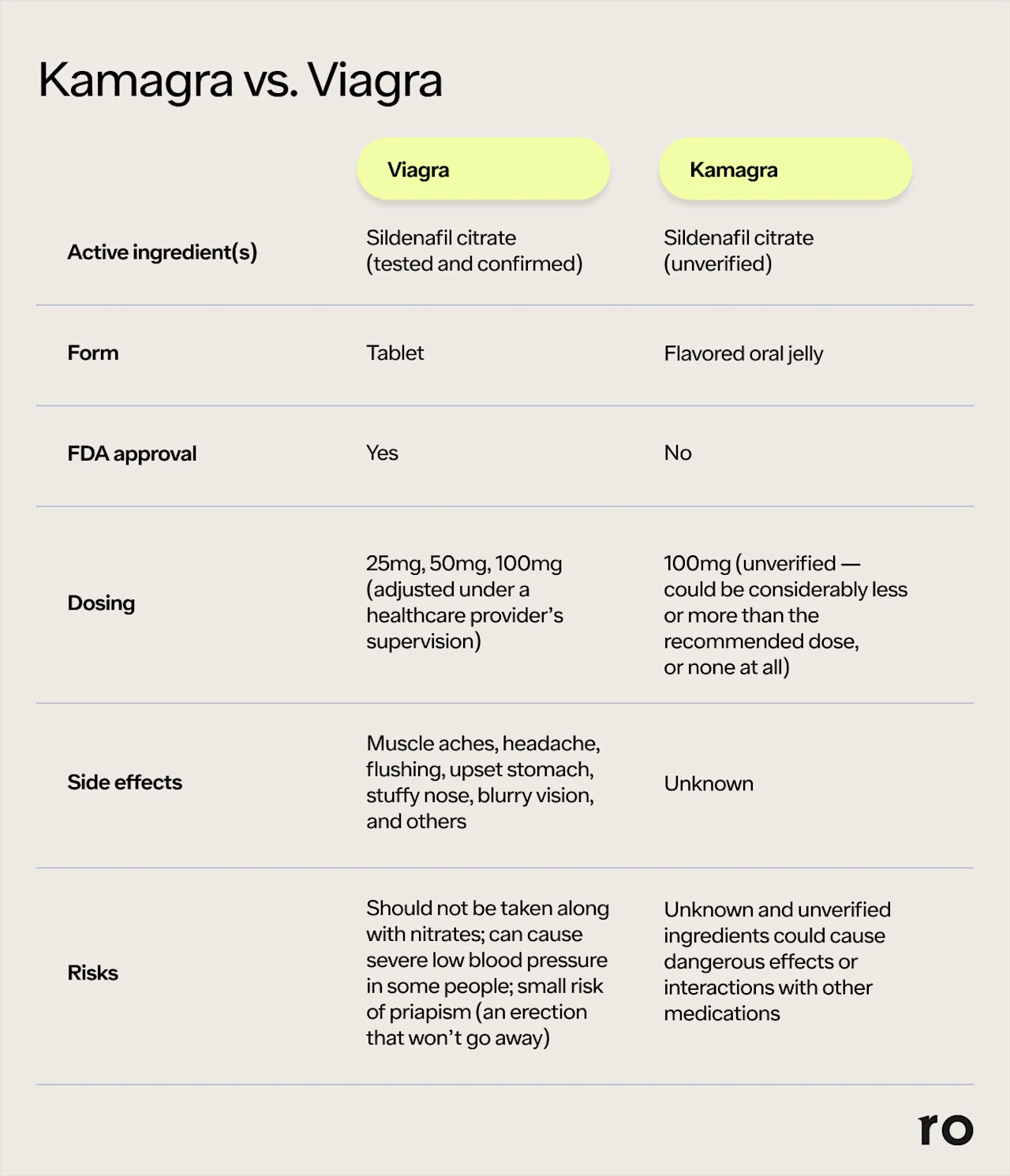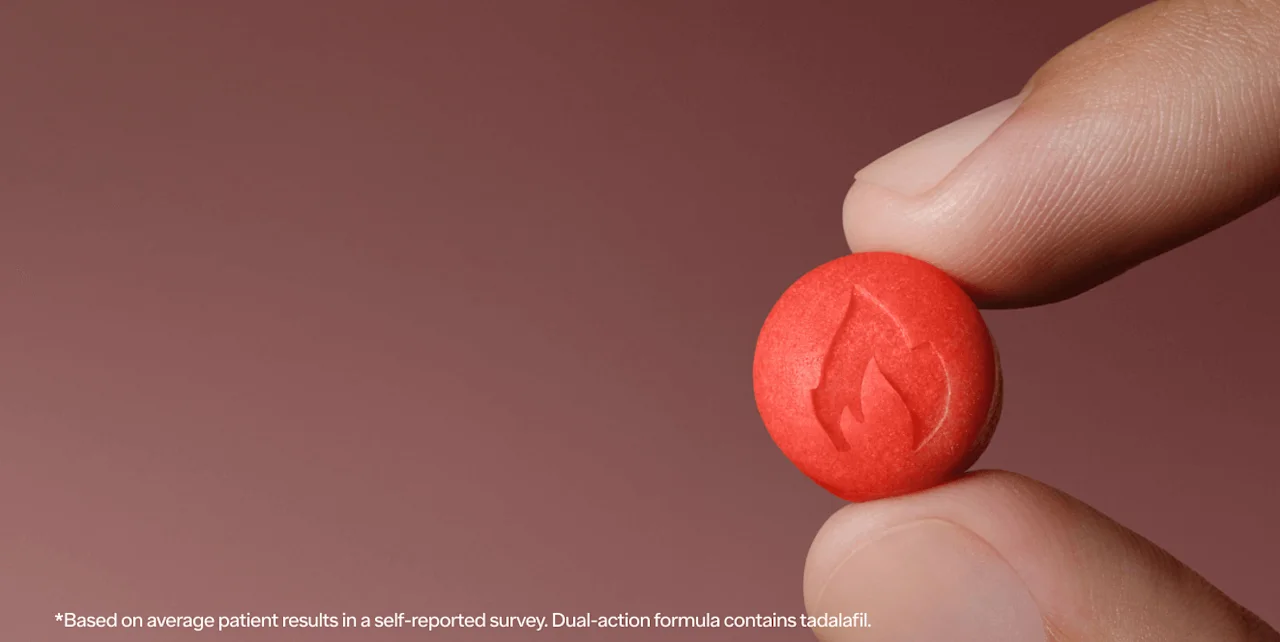Key takeaways
Kamagra oral jelly is a product that claims to treat erectile dysfunction (ED), but it’s unregulated, illegal in the US, potentially dangerous, and its ingredients are unverified.
Kamagra oral jelly claims to have the same active ingredient as Viagra (sildenafil), but there’s no way to verify if this is true or how much it contains.
If you have ED, there are safe, effective treatments available, like Viagra or Cialis. Lifestyle factors, like your diet, exercise routine, smoking or drinking habits, and your overall mental health all play a role in ED, too.
Here's what we'll cover
Here's what we'll cover
Here's what we'll cover
Key takeaways
Kamagra oral jelly is a product that claims to treat erectile dysfunction (ED), but it’s unregulated, illegal in the US, potentially dangerous, and its ingredients are unverified.
Kamagra oral jelly claims to have the same active ingredient as Viagra (sildenafil), but there’s no way to verify if this is true or how much it contains.
If you have ED, there are safe, effective treatments available, like Viagra or Cialis. Lifestyle factors, like your diet, exercise routine, smoking or drinking habits, and your overall mental health all play a role in ED, too.
The market is full of over-the-counter sexual enhancement products that claim to improve virility, boost erections, or even increase penis size. One such product is Kamagra oral jelly — a so-called quick fix that raises plenty of questions about safety, effectiveness, and whether it’s just another snake-oil scam.
If you struggle with erectile dysfunction (ED), it may be tempting to seek out easy solutions you can grab at the gas station, but we can’t stress this enough: Knockoff and unlicensed erectile dysfunction products are, at best, ineffective, and at worst, very dangerous.
Kamagra oral jelly is not approved in the United States (US), and it may carry the same risks as any unlicensed product that claims to provide Viagra-like results. Buying unlicensed products is an unnecessary risk, especially with so many better treatments out there. Continue reading to learn more about Kamagra oral jelly for ED, the risks of taking it, and alternative treatment options for erectile dysfunction.
What is Kamagra oral jelly?
Kamagra oral jelly is a product claiming to treat erectile dysfunction, but unlike its better-known counterparts Viagra (sildenafil) and Cialis (tadalafil), it’s not approved or regulated by the US Food and Drug Administration (FDA). If a drug isn’t approved by the FDA, it’s illegal to mail or bring it into the US, period.
Kamagra comes in single-use packets of flavored, edible jelly. According to sites that sell Kamagra online, each packet of jelly contains sildenafil, the active ingredient in Viagra. But as an unregulated product, there’s no way to know if it actually contains sildenafil, how much it includes, or what else is in the product. Kamagra gel hasn’t gone through the rigorous process of research and clinical trials needed to ensure that the product is safe and effective, as required for the FDA to even consider approval.
And while Kamagra products may be more easily available for purchase in parts of Europe than in the US, that doesn’t mean the jelly is approved by their medical boards, either.
What else do we know about Kamagra oral jelly? The answer is, unfortunately, not much. Let’s take a closer look at why this particular treatment option isn’t such a good idea.
Does Kamagra oral jelly work for ED?
The short answer is we don’t really know, but probably not. If anything, the evidence points to Kamagra and similar products doing more harm than good.
A quick Google search for Kamagra oral jelly will direct you to countless online “pharmacies” selling this product, usually as some variation of “Kamagra 100mg sildenafil” because, you guessed it, they claim to contain 100mg of sildenafil.
As we’ve mentioned, sildenafil is the active ingredient in Viagra, but here’s a bit more about what that is (and why you can’t trust what’s on these unverified Kamagra jelly labels). Viagra (along with similar drugs like Cialis) is part of a drug class called PDE5 inhibitors (which stands for phosphodiesterase type-5 inhibitors). In the simplest terms, these drugs work for ED by increasing blood flow to the penis, allowing for stronger erections.
Studies on counterfeit Viagra have shown that around 90% of these products contain either considerably less (as little as zero) or considerably more (as much as over 200%) of the active ingredient they claim to contain.
On top of incorrect dosing, many counterfeit Viagra products have also been found to contain toxic materials, like acetone, paint, and printer ink or contaminated with bacteria.
Is there a chance you could get lucky and buy Kamagra jelly with the correct dosing of sildenafil and no other toxic materials? A minuscule chance, sure, but we don’t think it’s worth the risk.
Kamagra vs. Viagra
Aside from Viagra being FDA-approved and regulated, while Kamagra is not, how do they compare? They differ in most ways, including their ingredients, dosing, formulation, and risks. Let’s take a closer look.

What are the risks of Kamagra oral jelly?
As you can see, the risks of Kamagra far outweigh the benefits. Sure, a fruit-flavored jelly that doesn’t break the bank might sound like a desirable alternative to making an appointment with your doctor to discuss your erectile dysfunction, sharing personal details about your sex life, picking up a prescription, and so on. But the bottom line is Kamagra oral jelly is not safe or legal.
Let's say Kamagra oral jelly does contain sildenafil, as it claims. Even so, there's no way to know what else might be in an unlicensed, unregulated product. Because Kamagra is not approved by the FDA, the only way to obtain the jelly in the US is illegally online or through an unlicensed provider. Here are some of the risks of purchasing and using Kamagra oral jelly (or any unregulated product).
Counterfeit ingredients
Research shows that erectile dysfunction medication (sildenafil) is one of the most counterfeited drugs out there. In fact, 90% of ED drugs sold online may contain counterfeit ingredients. Contaminants found in these drugs include talcum powder, commercial paint, and printer ink.
One analysis from the same research found that only 10.1% of erectile dysfunction medications purchased online came within 10% of the dosage of sildenafil that was advertised on the “label.” That means that 90% of the ED medications sampled contained more or less of the active ingredient than they claimed. At best, this means the medication may be ineffective. At worst, too much sildenafil may cause dangerous side effects and/or fatal drug interactions.
Drug interactions and comorbidities
Erectile dysfunction medication can interact dangerously with certain medications for heart disease, high blood pressure, and more, including nitrates and alpha blockers. When you get ED meds through a licensed healthcare provider, they’ll take your full medical and drug history into account to ensure there are no dangerous interactions or contraindications. The same can’t be said for an unlicensed distributor selling you Kamagra oral jelly.
ED is commonly experienced by people of all ages; an estimated 30 million people in the US experience ED. Occasionally, though, erectile dysfunction can be a sign of a more serious illness, like heart disease. By forgoing treatment from a licensed healthcare provider who can help you rule out potential serious underlying causes, you put yourself at higher risk for dangerous comorbidities.
Possible side effects
With all medications, there’s always the risk of some side effects. Sildenafil citrate, the active ingredient in Viagra and allegedly Kamagra, can have side effects, especially when it’s given at a higher dose than recommended by a healthcare provider.
Side effects of sildenafil include but are not limited to:
Low blood pressure (hypotension) and fainting
Hearing loss
Loss of vision
Priapism (a painful erection lasting more than 4 hours)
Excessive bleeding
Your healthcare provider will typically prescribe you a lower dose of Viagra or other PDE5 inhibitors like Cialis, to help your body adjust to the medication, then gradually increase the dosage as needed to minimize your risk of serious side effects.
With Kamagra oral jelly, we can’t say for sure how much sildenafil is contained in each packet, which means an increased risk of serious side effects. The risks of taking unregulated erectile dysfunction medications are very real and potentially deadly.
Alternatives to Kamagra oral jelly for ED
It is not recommended to take Kamagra oral jelly or any other drugs purchased online from an unlicensed pharmacy. However, there are plenty of safe and effective options available for treating your ED.
PDE5 inhibitors
The real-deal PDE5 inhibitors are effective, safe, and well-tolerated by most patients. This drug class includes Viagra (sildenafil), vardenafil, Cialis (tadalafil), and Stendra (avanafil).
Here’s how they work: PDE5 is an enzyme that breaks down a chemical called cyclic guanosine monophosphate (cGMP). cGMP causes the blood vessels in the penis to relax. When PDE5 is blocked by PDE5 inhibitors, cGMP increases, causing more blood to flow into the penis. More blood flow to the penis makes for stronger erections.
Here’s more info about each of the different PDE5 inhibitors:
Sildenafil (Viagra): Sildenafil is the generic name for Viagra. It is also marketed as Revatio, but that brand name is only FDA-approved for a condition called pulmonary arterial hypertension. At the highest dose (100 mg), about 82% of men taking sildenafil reported an improvement in their erections in clinical studies. It works within 30–60 minutes of taking it, and it's best if you don't take it with a heavily fatty meal.
Tadalafil (Cialis): Cialis is the brand name for tadalafil. This drug works similarly to sildenafil, but it has a longer half-life, which means that it lasts longer in the body (15–17.5 hours vs. sildenafil’s 4–6 hours). It should be taken 30 minutes to two hours before sexual activity.
Vardenafil: This drug has a similar profile to sildenafil, but it's more potent. That doesn't necessarily mean it works better, but the medication comes in lower doses than sildenafil. You should take it about 30–60 minutes before sexual intercourse.
Avanafil (Stendra): Avanafil is a newer PDE5 inhibitor that's currently only available under the brand name, Stendra. It's not used very widely at this point (likely because it's more expensive since it's still under patent), but a big advantage is it works within 15 minutes of taking it, and it lasts for up to 6 hours.
You can also consider other formulations, like Ro Sparks (a dissolvable formula that contains sildenafil and tadalafil) or Daily Rise Gummies (chewable gummies containing tadalafil). If the easy delivery system of Kamagra oral jelly is what’s most appealing about it, Ro Sparks or Daily Rise Gummies are far better alternatives. Their formulations are off-label, but they contain verified, FDA-approved active ingredients, so you know you’re getting safe and effective doses.
Injectable and intraurethral therapies
PDE5 inhibitors are the first-line treatment for ED. But, if you don’t respond well to PDE5 inhibitors or are unable to take them due to drug interactions or comorbidities, you still have options.
One such option is an injection administered into the shaft of the penis. Alprostadil is an injectable medication available under the brand names Caverject or Edex. Much like PDE5 inhibitors, alprostadil lets blood flow more freely into the penis, resulting in a stronger, longer-lasting erection. Unlike PDE5s, however, alprostadil doesn’t require sexual arousal to cause an erection.
Alprostadil may also be used as an intraurethral medication in the form of a pellet or gel that gets inserted into the penis. However, Muse, a brand-name alprostadil pellet, is no longer available in the US. Instead, your healthcare provider may prescribe a compounded medication that contains alprostadil, possibly in combination with other medications. A compounded medication is custom-made by a pharmacist when standard options don’t meet a patient’s needs or aren’t commercially available.
For example, some compounding pharmacies make a urethral formulation called BiMix (typically a combination of two medications: papaverine and phentolamine), and another is called TriMix (a combination of three medications: papaverine, phentolamine, and alprostadil).
Shockwave therapy
Low-intensity extracorporeal (external) shockwave therapy (LISWT) is a more recently developed ED treatment. Some studies show that shockwave therapy can restore blood flow in the penis and improve rigidity. This research also found that shockwave therapy may improve response to PDE5 medications like Viagra.
Surgical implant
Often used as a last resort, a surgical implant is a device or prosthetic that gets surgically inserted into the penis. Surgery is an extreme measure when it comes to treating ED, but most patients who undergo the procedure are satisfied with their results, and there are limited complications.
Lifestyle changes
ED is highly correlated with heart disease, obesity, diabetes, high blood pressure, smoking, heavy alcohol use, and depression. Most of these factors can be managed through lifestyle modifications, which can improve your erectile function. Consider making the following changes to your lifestyle:
Exercise regularly: Proper blood flow is the key to strong erections, and regular exercise is one of the best ways to get your blood flowing. Research shows that men who exercise regularly — especially with moderate-to-intense aerobic activity — have better ED outcomes.
Lose weight: Aside from the other benefits of a healthy diet and exercise routine, weight loss can help you overcome ED if obesity is a major factor. If you’re struggling with your weight, medications like Zepbound (tirzepatide) and Wegovy (semaglutide) can help.
Quit smoking: Smoking is known to damage the blood vessels, which can wreak havoc on your sexual health. The good news is, even if you smoke, quitting has been shown to improve the quality of erections by 25% after the first year.
Decrease alcohol intake: Heavy drinking is associated with higher rates of ED, likely also because of damage to the blood vessels and other essential functions. If you drink more than the moderate amount of two drinks per day (for men), it’s a good idea to cut back — both for ED and overall health.
Get mental health treatment: There’s a two-way relationship between mental health struggles (like depression and anxiety) and ED. Men with depression are 40% more likely to have ED; on the other hand, having ED triples your risk of developing depression. All that’s to say that getting mental health treatment from a therapist or with medication is very important.
Bottom line
If you have ED, don’t turn to potentially dangerous substances like Kamagra oral jelly. There are far better, safer, and more effective options available.
Kamagra oral jelly is an unregulated product that claims to contain sildenafil, the active ingredient in Viagra. There’s no way to verify that it contains it at all, or in what dose, and it could contain dangerous amounts or toxic ingredients. It’s illegal in the US.
ED medications, like the real-deal Viagra or Cialis, are safe, effective, and well-tolerated by most people. It’s also easier than ever to get them discreetly online through reputable providers, such as Ro.
Other treatments for ED include injections, implants, and lifestyle changes.
Frequently asked questions (FAQs)
Is Kamagra more potent than Viagra?
No, Kamagra is not more potent than Viagra. It’s unknown if it actually contains sildenafil (the active ingredient in Viagra) at all, or in what dose. Also, a higher dose isn’t always more effective; in many cases, it’s just more dangerous and puts you at higher risk of side effects.
How long does it take for Kamagra oral jelly to work?
There’s no way to know for sure, as there’s been no research on Kamagra oral jelly. We know, however, that Viagra takes about 30–60 minutes to kick in.
Is Kamagra legal in the US?
No, Kamagra is not legal in the US. If a medication isn’t approved by the FDA, it’s illegal to bring it into the U.S. — even if you order it online or get it abroad. Be wary of anyone selling Kamagra online or in person — they are selling unverified, potentially dangerous substances.
DISCLAIMER
If you have any medical questions or concerns, please talk to your healthcare provider. The articles on Health Guide are underpinned by peer-reviewed research and information drawn from medical societies and governmental agencies. However, they are not a substitute for professional medical advice, diagnosis, or treatment.
Viagra Important Safety Information: Read more about serious warnings and safety info.
Cialis Important Safety Information: Read more about serious warnings and safety info.
Zepbound Important Safety Information: Read more about serious warnings and safety info.
Wegovy Important Safety Information: Read more about serious warnings and safety info.
References
Bauer, S. R., Breyer, B. N., Stampfer, M. J., et al. (2020). Association of diet with erectile dysfunction among men in the health professionals follow-up study. JAMA Network Open, 3(11), e2021701. doi: 10.1001/jamanetworkopen.2020.21701. Retrieved from https://pubmed.ncbi.nlm.nih.gov/33185675/
Dhaliwal, A. & Gupta, M. (2020). PDE5 Inhibitor. StatPearls. Retrieved from https://www.ncbi.nlm.nih.gov/books/NBK549843/
Gong, B., Ma, M., Xie, W., et al. (2017). Direct comparison of tadalafil with sildenafil for the treatment of erectile dysfunction: a systematic review and meta-analysis. International Urology and Nephrology, 49(10), 1731–1740. doi: 10.1007/s11255-017-1644-5. Retrieved from https://www.ncbi.nlm.nih.gov/pmc/articles/PMC5603624/
Hatzimouratidis, K., Amar, E., Eardley, I., et al. (2010). Guidelines on male sexual dysfunction: erectile dysfunction and premature ejaculation. European Urology, 57(5), 804–814. doi: 10.1016/j.eururo.2010.02.020. Retrieved from https://pubmed.ncbi.nlm.nih.gov/20189712/
Hernández-Cerda, J., Bertomeu-González, V., Zuazola, P., & Cordero, A. (2020). Understanding Erectile Dysfunction in Hypertensive Patients: The Need for Good Patient Management. Vascular Health and Risk Management, 16, 231–239. doi: 10.2147/VHRM.S223331. Retrieved from https://www.ncbi.nlm.nih.gov/pmc/articles/PMC7297457/
Jackson, G., Arver, S., Banks, I., & Stecher, V. J. (2010). Counterfeit phosphodiesterase type 5 inhibitors pose significant safety risks. International Journal of Clinical Practice, 64(4), 497–504. doi: 10.1111/j.1742-1241.2009.02328.x. Retrieved from https://www.ncbi.nlm.nih.gov/pmc/articles/PMC3069491/
Jain, A. & Iqbal, O. A. (2020). Alprostadil. StatPearls. Retrieved from https://www.ncbi.nlm.nih.gov/books/NBK542217/
Katz, E. G., Tan, R. B., Rittenberg, D., & Hellstrom, W. J. (2014). Avanafil for erectile dysfunction in elderly and younger adults: differential pharmacology and clinical utility. Therapeutics and Clinical Risk Management, 10, 701–711. doi: 10.2147/TCRM.S57610. Retrieved from https://www.ncbi.nlm.nih.gov/pmc/articles/PMC4155803/
Leslie, S. W. & Sooriyamoorthy, T. (2024). Erectile dysfunction. StatPearls. Retrieved on Jul. 24, 2025 from https://www.ncbi.nlm.nih.gov/books/NBK562253/
Liu, Q., Zhang, Y., Wang, J., et al. (2018). Erectile dysfunction and depression: a systematic review and meta-analysis. The Journal of Sexual Medicine, 15(8), 1073–1082. doi: 10.1016/j.jsxm.2018.05.016. Retrieved from https://pubmed.ncbi.nlm.nih.gov/29960891/
Sansone, A., Cuzin, B., & Jannini, E. A. (2021). Facing counterfeit medications in sexual medicine. a systematic scoping review on social strategies and technological solutions. Sexual Medicine, 9(6), 100437. doi: 10.1016/j.esxm.2021.100437. Retrieved from https://pubmed.ncbi.nlm.nih.gov/34619517/
Silva, A. B., Sousa, N., Azevedo, L. F., & Martins, C. (2017). Physical activity and exercise for erectile dysfunction: systematic review and meta-analysis. British Journal of Sports Medicine, 51(19), 1419–1424. doi: 10.1136/bjsports-2016-096418. Retrieved from https://pubmed.ncbi.nlm.nih.gov/27707739/
Smith, B. P. & Babos, M. (2023). Sildenafil. StatPearls. Retrieved on Jul. 23, 2025 from https://www.ncbi.nlm.nih.gov/books/NBK558978/
Tharyan, P. & Gopalakrishanan, G. (2006). Erectile dysfunction. BMJ Clinical Evidence, 2006, 1803. Retrieved from https://www.ncbi.nlm.nih.gov/pmc/articles/PMC2907627/
Tyski, S., Burza, M., & Laudy, A. E. (2025). Microbiological Contamination of Medicinal Products -Is It a Significant Problem? Pharmaceuticals (Basel, Switzerland), 18(7), 946. doi: 10.3390/ph18070946 Retrived from https://pmc.ncbi.nlm.nih.gov/articles/PMC12300887/
U.S. Customs and Border Protection. (2025). Can I bring in medications, medical devices, needles, or oxygen tanks while visiting the United States? Retrieved from https://www.help.cbp.gov/s/article/Article1888?language=en_US
U.S. Food and Drug Administration (FDA). (2007). Revatio (sildenafil citrate) tablets. Retrieved on Jan. 20, 2021 from https://www.accessdata.fda.gov/drugsatfda_docs/label/2009/021845s005lbl.pdf
U.S. Food and Drug Administration (FDA). (2022). Stendra (avanafil) tablets, for oral use. Retrieved on Jan. 20, 2021 from https://www.accessdata.fda.gov/drugsatfda_docs/label/2022/202276s020lbl.pdf
Vena, W., Vaccalluzzo, L., LA Vignera, S., et al. (2023). Low-intensity shockwave treatment (LISWT) improves penile rigidity in eugonadal subjects with erectile dysfunction: a pilot study. Minerva Endocrinology, 48(1), 4–11. doi: 10.23736/S2724-6507.21.03686-1 Retrieved from https://pubmed.ncbi.nlm.nih.gov/34931511/













